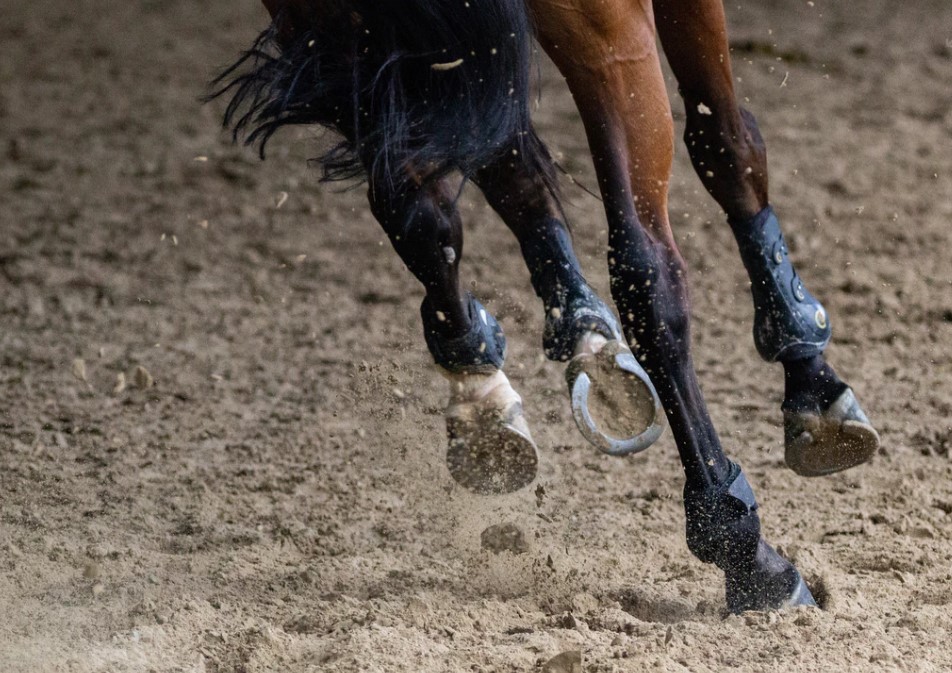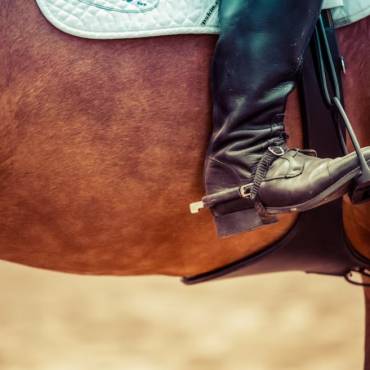Exhausted horse syndrome refers to a range of metabolic and physiologic conditions that may occur when horses become fatigued. Affected horses may display a decrease in energy, appetite or appear stiff and weak. In serious cases, cardiac arrhythmias, shock, muscle damage, colic and diarrhea may develop. Horses that are under-conditioned, performing in endurance events or exercised in hot or humid environments are at higher risk for exhaustion. If exercise is not immediately halted and treatment initiated, then life-threatening complications may occur.
Exhaustion may develop with any prolonged period of exercise such as endurance rides, three-day events and extended trail rides. Many factors contribute to the potential for exhaustion. Different breeds are better suited to prolonged exercise while others excel at shorter, more high intensity work. The animal’s training and fitness ideally should be suited for the event they are participating in, although even highly prepared animals may develop exhaustion. Any underlying disease, including lameness, anemia and respiratory disease will increase the risk of fatigue.
Exhaustion is a multifactorial condition. Heat, electrolyte imbalance and energy stores may contribute. A large amount of heat is produced while exercising. Heat needs to be appropriately regulated and removed from an exercising animal via sweat and air movement. If heat is not removed, then the core body temperature steadily increases. Approximately 65% of heat is lost via sweat, 25% via respiratory evaporation and the remaining 10% via other mechanisms. This is made more difficult when the conditions include high heat and humidity or when the animal is dehydrated.
Sweat contains important electrolytes such as sodium, potassium, calcium and chloride, which are lost as the horse sweats. If electrolyte imbalances are not corrected, then serious derangements occur leading to shifts in blood pH and cellular stability. The primary energy source for muscles is stored glycogen, which is a finite resource. Glycogen stores can be increased with training and exercise, but once depleted the muscle lacks a primary energy source and exercise will slow or stop.
Horses with exhaustion will have an increased heart rate, temperature and respiratory rate. They may appear depressed, unwilling to eat and drink, and, in some cases, develop colic, shock or laminitis. Horses that move with a stiff gait may have significant muscle damage and/or laminitis. These animals should not be forced to move if treatment can be provided on site.
Affected horses are typically dehydrated and blood work shows evidence of stress and electrolyte imbalances. Muscle enzyme values will be increased and often continue to increase as muscle damage continues. Kidney values, which reflect both dehydration and renal damage, may be elevated and urine may be significantly decreased in volume and dark brown/red in color. Genetic testing, muscle biopsy or other diagnostic testing may be needed to determine an underlying cause in cases of repeated myopathy or suspected exhaustion.
Treatment includes immediately stopping exercise and initiating assisted cooling. This can be done with electric fans and running large volumes of cold water over the entire body. Intravenous fluids can be given to restore hydration and electrolyte status. Once there is evidence that the intestinal tract is functioning, then oral fluids may be added to aid hydration; however, these should not be administered until the horse has good gut sounds and no signs of colic. Horses should not be transported following exhaustion until cleared by their medical team.
Exhaustion is best prevented by acclimatization, proper training, nutrition and supplementation of electrolytes. Electrolyte products require adequate water intake to be effective. Horses given concentrated electrolytes without appropriate water consumption will actually increase dehydration. Acclimatization to a climate with excessive heat, altitude or humidity may take up to two weeks.
Conditioning will create larger muscle glycogen stores, improve efficiency of heat elimination, and train horses to eat and drink during prolonged work. It is also important to allow horses enough time to recover and rehydrate from transport prior to beginning competition.
Event organizers will assess the safety associated with heat and humidity, and events may need to be cancelled if environmental conditions are considered dangerous. A rider may be the first to recognize that their horse is displaying abnormal behavior or unwillingness to work, which is often an early sign of exhaustion. Vet checks throughout endurance events are designed to identify horses showing early signs of fatigue. These checks may require horses be rested or removed from competition before serious complications occur.
~ Rebecca Ruby, MSc, BVSc, Dipl. AVCP, is an assistant professor and veterinary pathologist at the UK Veterinary Diagnostic Laboratory
Original article: Recognizing and Preventing Exhaustion in Horses (horsesport.com)





Add Comment